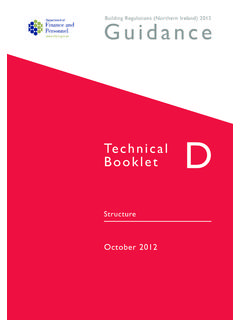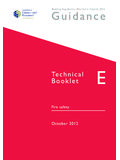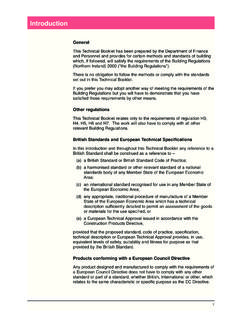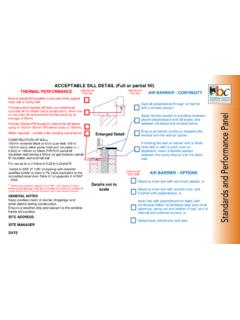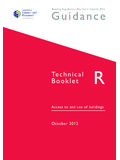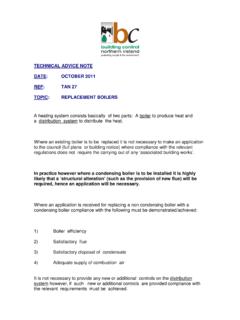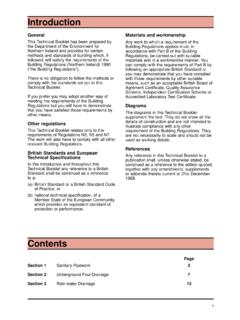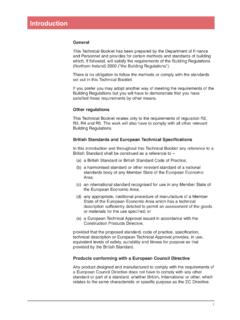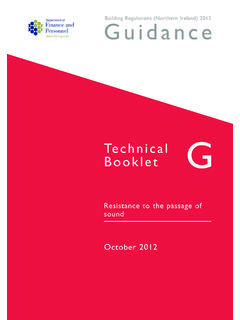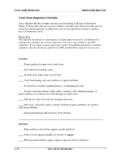Transcription of Technical Booklet - Building Control NI
1 Guidance Department of Building Regulations (Northern Ireland) 2012. Finance and Personnel Te c h n i c a l Booklet L. Combustion appliances and fuel storage systems October 2012. Contents page Introduction Technical Booklets 3. This Technical Booklet 3. Protected buildings 4. Other legislation 4. Part L Regulations 7. Guidance Performance and introduction to provisions 10. Section 1 General Definitions 13. Section 2 General provisions for combustion appliances Air supply and ventilation 21. Flues and chimneys 25. Dry lining around fireplace openings 33. Condition of combustion installations at completion 33. Notice plates for hearths and flues 33. Access to combustion appliances for maintenance 34. Detection and warning of the presence of carbon monoxide 35. Section 3 Solid fuel burning appliances (including solid biofuel) with a rated heat output up to 50 kW.
2 Air supply to appliances 36. Flues and chimneys 37. Hearths 46. Fireplace recesses and prefabricated appliance chambers 50. Technical Booklet L: 2012 Combustion appliances and fuel storage systems 1. Section 4 Gas burning appliances with a rated heat input up to 70 kW (net). Gas burning appliances 53. Air supply and ventilation 55. Flues and chimneys 58. Bases for back boilers 64. Hearths for gas burning appliances 65. Shielding of appliances 66. Section 5 Oil burning appliances (including liquid biofuel) with a rated heat output up to 45 kW. Class of oil 67. Appliances fitted in bedrooms, bathrooms and shower rooms 67. Air supply and ventilation 67. Flues and chimneys 69. Shielding of oil-fired appliances 77. Section 6 Liquid fuel (including liquid biofuel) storage and supply Oil storage installations 78. Liquefied Petroleum Gas (LPG) storage installations 80.
3 Appendix A Inspection and testing of flues, chimneys and flue pipes 83. Appendix B Informative European chimney designations 87. Appendix C Assessing air permeability of older dwellings in relation to permanent ventilation requirements 91. Appendix D Informative LPG cylinders 92. Appendix E Publications referred to 93. 2 Combustion appliances and fuel storage systems Technical Booklet L: 2012. Introduction Technical Booklets This Technical Booklet , which takes effect on 31st October 2012, is one of a series that has been prepared by the Department of Finance and Personnel (the Department) for the purpose of providing practical guidance with respect to the Technical requirements of the Building Regulations (Northern Ireland) 2012 (the Building Regulations). At the back of each Technical Booklet is a list of all the Technical Booklets that have been prepared and published by the Department for this purpose.
4 The guidance given in a Technical Booklet includes performance standards and design provisions relating to compliance with specific aspects of the Building Regulations for the more common Building situations. If the guidance in a Technical Booklet is followed there will be a presumption of compliance with the requirements of those Building Regulations covered by that guidance. However, this presumption can be overturned, so simply following the guidance does not guarantee compliance. For example, if a particular circumstance is not one of the more common Building situations the design provisions given in the Technical Booklet may not be appropriate. There are likely to be alternative ways of demonstrating compliance with the relevant requirements of the Building Regulations other than by following a design provision given in a Technical Booklet .
5 There is therefore no obligation to adopt any particular provision set out in a Technical Booklet , should you decide to comply in some other way. However, you will have to demonstrate that your alternative solution meets the relevant requirements of the Building Regulations by those other means. This Technical Booklet Requirements The guidance contained in this Technical Booklet relates only to the requirements of regulations 70, 71, 72, 73, 74, 75, and 76. The work will also have to comply with all other relevant requirements of the Building Regulations. Materials and workmanship Any Building work which is subject to requirements imposed by Part A of the Building Regulations should be carried out in accordance with regulation 23. of those regulations. Guidance on meeting these requirements for materials and workmanship is given in Technical Booklet B which supports Part B.
6 Technical Booklet L: 2012 Combustion appliances and fuel storage systems 3. The Building Regulations are made for specific purposes, primarily securing the health, safety, welfare and convenience of people and for the conservation of fuel and power. Standards and Technical approvals are relevant guidance to the extent that they relate to these purposes. However, they may also address other aspects of performance such as serviceability, or aspects which although they relate to health and safety are not covered by the Building Regulations. Named standards Where this Technical Booklet makes reference to a named standard, the relevant version of the standard is the one listed in Appendix E. However, if this version has been replaced or updated by the issuing standards body, the new version may be used as a source of guidance provided that it continues to address the relevant requirements of the Building Regulations.
7 Diagrams The diagrams in this Technical Booklet supplement the text. They do not show all the details of construction and are not intended to illustrate compliance with any other requirement of the Building Regulations. They are not necessarily to scale and should not be used as working details. Protected buildings District councils have a duty to take account of the desirability to preserve the character of protected buildings when carrying out their functions under Building Regulations. Therefore, where work is to be carried out to a protected Building to comply with Part L or any other Part of the Building Regulations, special consideration may be given to the extent of such work for compliance where it would unacceptably alter the character or appearance of the Building . Protected buildings are defined in Article 3A(2).
8 Of the Building Regulations (Northern Ireland) Order 1979 (as amended). Other legislation The provisions of this Technical Booklet relate to the requirements of Building Regulations and do not include measures which may be necessary to meet the requirements of other legislation. Such other legislation may operate during the design or construction stages or when a Building is brought into use and can extend to cover aspects which are outside the scope of the Building Regulations. The Workplace (Health, Safety and Welfare) Regulations (Northern Ireland) 1993. The Workplace (Health, Safety and Welfare) Regulations (Northern Ireland). 1993 (the Workplace Regulations) contain some requirements which affect Building design. The main requirements are now covered by the Building Regulations, but for further information see The Workplace Regulations and the Workplace Health, Safety and Welfare Approved Code of Practice.
9 4 Combustion appliances and fuel storage systems Technical Booklet L: 2012. The Workplace Regulations apply to the common parts of flats and similar buildings if people such as cleaners, wardens and caretakers are employed to work in these common parts. Where the requirements of the Building Regulations that are covered by Part L do not apply to dwellings, the provisions may still be required in the situations described above in order to satisfy the Workplace Regulations. The Clean Air (Northern Ireland) Order 1981. Under the Clean Air (Northern Ireland) Order 1981 a district council may declare the whole or part of a district of the council to be a smoke Control area. It is an offence to emit smoke from a chimney of a Building , from a furnace or from any fixed boiler if located in a designated smoke Control area unless an authorised fuel is used.
10 It is also an offence to acquire an unauthorised fuel ' for use within a smoke Control area unless it is used in an exempt' appliance ( exempted' from the controls which generally apply in the smoke Control area). Authorised fuels are fuels which are authorised under the Clean Air (Northern Ireland) Order. These include inherently smokeless fuels such as gas, electricity and anthracite together with specified brands of manufactured solid smokeless fuels. These fuels have passed tests to confirm that they are capable of burning in an open fireplace without producing smoke. Exempt appliances are appliances (ovens, wood burners, boilers and stoves) which have been exempted by the Clean Air (Northern Ireland). Order. These have passed tests to confirm that they are capable of burning an unauthorised or inherently smoky solid fuel without emitting smoke.

